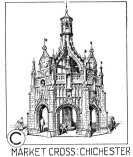The Tower Subway
Topic: History
Today is the anniversary of the official opening of the
Tower Subway in 1870. This deep tunnel, which took ten months to build and cost £16,000, was the world's first underground tube railway. The tunnel was lined with cast iron tubes in 18-inch sections 7/8th of an inch thick. It took passengers underneath the River Thames from Tower Hill on the north bank to the south side. The tunnel was designed and built by the English civil engineer and bridge builder,
Peter William Barlow, in conjunction with the engineer,
James Henry Greathead. Greathead developed Barlow's new method of digging deep tunnels, originally based on an earlier design by
Marc Isambard Brunel, (the father of
Isambard Kingdom Brunel), using an extremely efficient circular drilling shield. His improved design later became known as the 'Greathead Shield' [see this page on the history of
Tunnelling]. Before this invention, all tunnels had been built by the 'cut and cover' method. The expertise Greathead gained in building the Tower Subway was invaluable when later tube lines were built.
Unfortunately, the Tower Subway only operated as a tube railway for about three months as it didn't make enough money and the company went bankrupt. The problem was that it was a narrow single bore tunnel (7-ft in diameter) using one small cable car, which ran on a 2-ft 6 track. The railway was powered by a 4 horse power stationary steam engine on the south side of the tunnel which pulled the cable car along on an endless cable. The conditions were cramped and the car, which only carried twelve passengers at a time, had to shuttle back and forth along the 1,430-foot long track - each journey taking about 70 seconds.
The tunnel was immediately converted to a pedestrian walkway, with the cables ripped out and gas lights installed, and it re-opened in November 1870. It became a very popular way to cross the river averaging some 20,000 customers a week each paying one halfpenny for the privilege. This was in spite of the fact that there was little headroom and the conditions were said to be 'creepy'! However, the subway eventually closed to the public shortly after the newly constructed
Tower Bridge was opened in 1894.
In the 1920's, the tunnel was re-used as a route for water mains and hydraulic tubes, a major source of power in London at the time. Surviving damage during the bombing of World War II, the tunnel still carries water mains today and telecommunication cables instead of the hydraulic tubes which became obsolete in 1975.
Americans First On The Moon
Eagle touch-down in 'football pitch'
Topic: History
On the 20th July 1969, history was made when the Apollo ll mission became the first manned lunar mission to land on the moon. This is part of the leading article in The Daily Telegraph, a London newspaper, for Monday, July 21, 1969.

Two Americans became the first men in the moon last night when Apollo ll's lunar module Eagle touched down on the moons surface at 9.18 p.m. B.S.T. Aboard were Neil Armstrong, 38, mission commander, and Col. Edwin "Buzz" Aldrin, 39, Eagle's pilot.
As the lunar module settle gently on the Sea of Tranquility, Armstrong reported: "The Eagle has landed. We are breathing again. Thanks a lot".
Almost immediately, Mission Control began referring to Eagle with a new radio call-sign of "Tranquility Base". Armstrong radioed that the earth was "big, bright and beautiful."
He said: "We are in football pitch-sized crater." Houston congratulated Eagle with: "Beautiful job, you guys." A voice from Eagle replied: "Don't forget the one in the module."
Overhead at a height of less than 70 miles, Col. Michael Collins, 38, orbited the moon in the command module Columbia, to which Armstrong and Aldrin are due to return tonight.
P.S. If anyone is interested in the whole article, please let me know.
Crowned on this Day in 1509
Now Playing: I'm Henery the Eighth, I am
Topic: History

I always used to think of
Henry VIII, who was born on the 28th June 1491, as a particularly unpleasant monarch: a womanising, selfish, over-eating and cruel man. It seemed that he was responsible for so much evil during his reign. He turned against the Pope in 1532 and proclaimed himself Head of the Church of England so that he could 'divorce' his wife,
Catherine of Aragon (the marriage was actually annulled) and remarry. He dissolved the Roman Catholic monasteries, stole their chattels and their lands, vandalised and destroyed churches. During his reign, about 150,000 of his subjects were executed including his second wife,
Ann Boleyn, and his fourth wife,
Catherine Howard, who were both beheaded. Each of these unfortunate ladies had their marriages to the king annulled prior to their executions.
However, he is widely believed to be the composer of that lovely tune, "
Greensleeves" and, without doubt, he was an accomplished musician. He was highly educated and could converse in Latin, French and Spanish. He owned a large library of books, many with notes written in the margins in his hand. He was himself an author, publishing the
Assertio Septem Sacramentorum in 1521, and he wrote poetry. He was very tall for Tudor times (six feet two) and, in his youth, excelled at sports such as
Hare Coursing and
Royal Tennis.
So, what went wrong to turn him into such a tyrant in his later years? A sad, bloated old man, weighing around 28 stone, who trusted no one fully with the possible exception of his
court jester, Will Somers.
The young
Henry Tudor never expected to be King of England. He was the second son of
Henry VII and as such probably destined for the church. However, his brother, Arthur, Prince of Wales and heir apparent died at fifteen shortly after his marriage to Catherine of Aragon. At the time, Henry's father was very keen to secure an alliance with Spain and he was probably responsible for 'encouraging' the young Henry to seek a dispensation from the Pope to marry his brother's widow. Within fourteen months, the two were betrothed. However, by 1505, Henry VII had lost interest in an alliance with Spain and the young Henry was forced to declare that the engagement had been arranged without his agreement. Nevertheless, when Henry VII died, the King of Spain insisted on the marriage taking place and Henry married Catherine on 11th June 1509. They were both crowned at Westminster Abbey on 24th June 1509.
Did you know that they had a son, Henry, Duke of Cornwall? He was born on 1st January 1511 and died on 22nd February 1511. In fact, Catherine had six or seven pregnancies in all but only one child survived infancy, her daughter, Mary. It was when it was apparent that Catherine was too old to have any more children that Henry, who up to then had fathered at least six illegitimate children, decided he needed a male heir and resolved to marry again. History would have been so different if the baby Duke of Cornwall had lived!
I used to believe that Henry died of syphilis although there was no evidence of this disease in any of his children. Then I read an extremely interesting article in the April 2005 issue of the
BBC History Magazine which reported that new research suggests that Henry may have suffered from an endocrine abnormality called
Cushing's Syndrome. The symptoms are:
obesity, a 'buffalo' hump on the back, a swollen face with fat deposits beneath the eyes, irritability, depression, mood swings, paranoia, headaches, fatigue, aggression, impotence. This disease would have turned him into a psychotic paranoid with an erratic temper and could explain why he so often turned against those closest to him. He died on 28th January 1547, a feared and despised old man - a sad and ignominious end for one of Britain's most famous kings.
British Ceremonies and Pageantry
Now Playing: God Save The Queen
Topic: History
Every Maundy Thursday, the British Sovereign, Queen Elizabeth II, distributes Maundy Money at the
Ceremony of the Royal Maundy. This ancient custom dates back to the 13th century when the Sovereign gave gifts of food and clothing to the poor. As an act of humility, the Monarch would even wash the feet pf the recipients - as Christ washed the feet of his disciples before the Last Supper - although the last King to actually do this was
James II, who died in 1701.
Maundy Money consists of sets of small silver coins which are specially minted for the occasion. The Queen presents them to local deserving pensioners who are chosen because of their outstanding services to their church and community. During her reign, the ceremony has taken place each year in a different cathedral or abbey around the country. In 1986, it took place at
Chichester Cathedral and I seem to remember that we were all let out of our offices to line the route and wave to the Queen!
At the ceremony, each person receives two purses from the Queen, one red and one white. The white purse contains one silver Maundy coin for each year of the monarch's reign. The red purse contains ordinary money in place of the other gifts which used to be given to the poor. The silver Maundy coins originally consisted of a penny and a groat (4 pence). In 1551, a threepence was added and in 1667, a twopence.
It was
Henry IV (ruled 1399-1413) who instigated the practice of relating the number of people receiving maundy money to the sovereign's age and sex. This custom was revised under Queen Elizabeth II and now equal numbers of sets are presented to both male and female recipients. As the Queen is 79 this year, this means that 79 men and 79 women will be presented with Maundy sets at today's ceremony in
Wakefield Cathedral. [For a chuckle, also view this
news item!]
Victorian maundy money is fairly common as the general public could order sets from a bank. This changed, from 1908, when
King Edward VII instructed that only recipients involved in the ceremony were entitled to receive the sets. So after this date, Maundy coin sets became one of the most collectible and sought after numismatic items.






 I always used to think of
I always used to think of